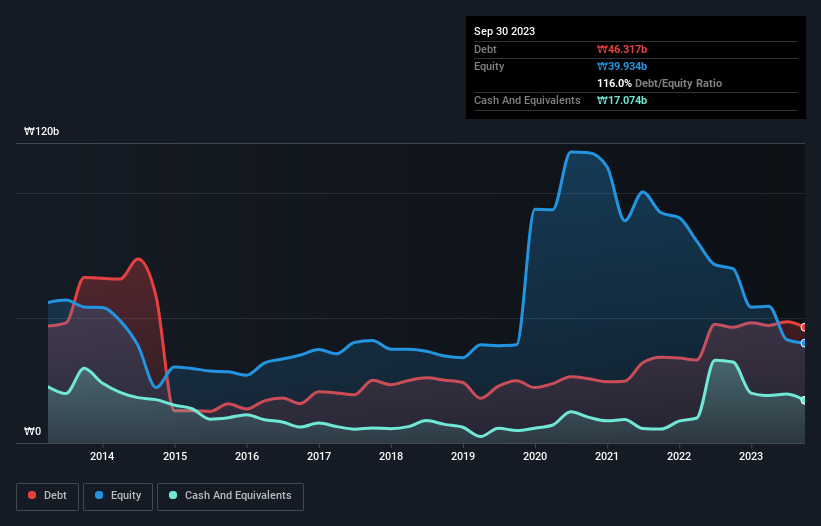- South Korea
- /
- Electrical
- /
- KOSDAQ:A027040
Is Seoul Electronics & Telecom (KOSDAQ:027040) Using Debt In A Risky Way?
The external fund manager backed by Berkshire Hathaway's Charlie Munger, Li Lu, makes no bones about it when he says 'The biggest investment risk is not the volatility of prices, but whether you will suffer a permanent loss of capital.' It's only natural to consider a company's balance sheet when you examine how risky it is, since debt is often involved when a business collapses. As with many other companies Seoul Electronics & Telecom Co., Ltd. (KOSDAQ:027040) makes use of debt. But the real question is whether this debt is making the company risky.
When Is Debt A Problem?
Generally speaking, debt only becomes a real problem when a company can't easily pay it off, either by raising capital or with its own cash flow. Part and parcel of capitalism is the process of 'creative destruction' where failed businesses are mercilessly liquidated by their bankers. However, a more common (but still painful) scenario is that it has to raise new equity capital at a low price, thus permanently diluting shareholders. Of course, the upside of debt is that it often represents cheap capital, especially when it replaces dilution in a company with the ability to reinvest at high rates of return. The first thing to do when considering how much debt a business uses is to look at its cash and debt together.
See our latest analysis for Seoul Electronics & Telecom
How Much Debt Does Seoul Electronics & Telecom Carry?
The chart below, which you can click on for greater detail, shows that Seoul Electronics & Telecom had ₩46.3b in debt in September 2023; about the same as the year before. However, because it has a cash reserve of ₩17.1b, its net debt is less, at about ₩29.2b.

A Look At Seoul Electronics & Telecom's Liabilities
Zooming in on the latest balance sheet data, we can see that Seoul Electronics & Telecom had liabilities of ₩38.5b due within 12 months and liabilities of ₩31.8b due beyond that. Offsetting this, it had ₩17.1b in cash and ₩9.93b in receivables that were due within 12 months. So it has liabilities totalling ₩43.3b more than its cash and near-term receivables, combined.
This deficit casts a shadow over the ₩28.3b company, like a colossus towering over mere mortals. So we'd watch its balance sheet closely, without a doubt. At the end of the day, Seoul Electronics & Telecom would probably need a major re-capitalization if its creditors were to demand repayment. There's no doubt that we learn most about debt from the balance sheet. But you can't view debt in total isolation; since Seoul Electronics & Telecom will need earnings to service that debt. So if you're keen to discover more about its earnings, it might be worth checking out this graph of its long term earnings trend.
In the last year Seoul Electronics & Telecom had a loss before interest and tax, and actually shrunk its revenue by 38%, to ₩39b. To be frank that doesn't bode well.
Caveat Emptor
Not only did Seoul Electronics & Telecom's revenue slip over the last twelve months, but it also produced negative earnings before interest and tax (EBIT). Indeed, it lost a very considerable ₩5.4b at the EBIT level. Considering that alongside the liabilities mentioned above make us nervous about the company. It would need to improve its operations quickly for us to be interested in it. Not least because it had negative free cash flow of ₩485m over the last twelve months. That means it's on the risky side of things. The balance sheet is clearly the area to focus on when you are analysing debt. However, not all investment risk resides within the balance sheet - far from it. We've identified 3 warning signs with Seoul Electronics & Telecom (at least 1 which is concerning) , and understanding them should be part of your investment process.
If you're interested in investing in businesses that can grow profits without the burden of debt, then check out this free list of growing businesses that have net cash on the balance sheet.
New: Manage All Your Stock Portfolios in One Place
We've created the ultimate portfolio companion for stock investors, and it's free.
• Connect an unlimited number of Portfolios and see your total in one currency
• Be alerted to new Warning Signs or Risks via email or mobile
• Track the Fair Value of your stocks
Have feedback on this article? Concerned about the content? Get in touch with us directly. Alternatively, email editorial-team (at) simplywallst.com.
This article by Simply Wall St is general in nature. We provide commentary based on historical data and analyst forecasts only using an unbiased methodology and our articles are not intended to be financial advice. It does not constitute a recommendation to buy or sell any stock, and does not take account of your objectives, or your financial situation. We aim to bring you long-term focused analysis driven by fundamental data. Note that our analysis may not factor in the latest price-sensitive company announcements or qualitative material. Simply Wall St has no position in any stocks mentioned.
About KOSDAQ:A027040
Seoul Electronics & Telecom
Produces and sells power transformers and switching mode power supply (SMPS) products in South Korea and internationally.
Mediocre balance sheet and slightly overvalued.
Market Insights
Community Narratives


Recently Updated Narratives


Engineered for Stability. Positioned for Growth.


MINISO's fair value is projected at 26.69 with an anticipated PE ratio shift of 20x


Fiverr International will transform the freelance industry with AI-powered growth
Popular Narratives


MicroVision will explode future revenue by 380.37% with a vision towards success


NVDA: Expanding AI Demand Will Drive Major Data Center Investments Through 2026



